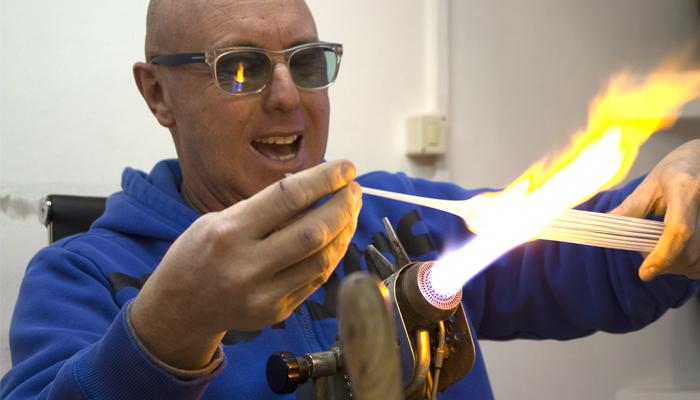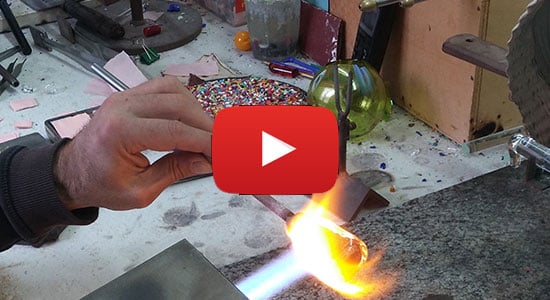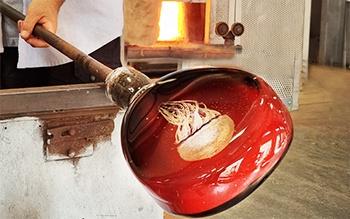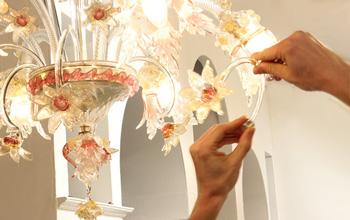Face to face with fire and glass: a lonely multi-century relationship.
Lampworking can be considered, related to the process which occurs in the furnace, the other major branch of Murano techniques referring to the glass.
It is an operation mostly solitary, during which the craftsman or artist is face to face with the vitreous material to which is ideally and practically connected via the flame of the torch - also called “Cannello” - he's using.

It is a working method of ancient origin, evolved from century to century, decade by decade, supported by technological inventions developed gradually over time. The name itself reveals the beginnings: the heat necessary to melt the glass was obtained from the flame of a candle lampfed from the air conveyed by a bellows activated by foot. Through the years this simple instrumentation has been replaced by a metallic tube connected to a propane or methane gas cylinder, nowadays mostly reinforced by oxygen emissions for increasing the temperature of the burning beam that is directed onto the glass.
Murano and Borosilicate glass: the only limit is the creativity of the artist
The two main strands of the lampworking technique are structured on two different types of glass: borosilicate glass, harder and more durable material that requires more heat to be worked, and the Murano glass, composed of sodium and calcium, more ductile, with a longer tradition and far more widespread in the island laboratories.
Both the processing based on the two types of glass involve the construction of objects through the development of filled and blown bodies. Regarding the creation of filled bodies the range of items that can be extracted from the vitreous mass is huge, and has as main limitation the artist's creativity: from classic pearls that could become pendings or necklaces to sculptures of plants and animals, from cats to horses; from elephants to beetles; fish and ducks, in a fancy swirl that can only enchant the viewer's eye and stimulate his own curiosity.
The practice of lampworking: between making and tools the 4 core points
The starting point is the sphere, almost every cases. To obtain the sphere the artisan or the artist heats the glass rod (a semifinished product that is sold in three different shades: transparent, pastel and opaline, for an almost unlimited range of color variations) under the flame, turning the wrist forward and backward in order to round up the rod’s end and transform it in a glowing sphere.
At that point, depending on what the product has to be, lampworkers can use various tools and specific movements for shaping the material until it takes on the desired appearance. One can rub the sphere on the “Bronzin" (the flat metal plate placed above the torch) with calm, rotator gestures, in order to impart to the melt a more cylindrical form (operation called "Marmorizar") or press it on the same surface but in a different way, with a greater inclination towards the edge, exerting the force necessary to bring out a tip ("Pontizar" in jargon).
In order to facilitate the grip on the glowing sphere in many cases is used a second rod, generally of lesser thickness, called "Ponteo": once in contact with the sphere the lampworker maintains its temperature slightly lower than the molten glass’s one, so to be able to use the "Ponteo" like an operational wand without mixing it with the hot mass in the definition phase.
The other fundamental tools of the lampworker are undoubtedly the gripper, which is essential to lengthen the white-hot ball and make it assume the desired shapes; the scissors; the “Tagliante”, a sort of cigar cutter that, in fact, in some cases is actually replaced by this specific object; the knife, which is useful to press on the glass to create depressions and thin concavities; and the “Molletta”, a tool made of iron or steel used to have a firm grip on the work and, thanks to a fiberglass fabric, at the same time cooling it slightly, which allows to the molten glass to not come into direct contact with the metal, avoiding thermal shocks which could compromise the solidity of the piece.

A constellation of laboratories scattered around the city: the glow of the lampworking
Here are the few simple instruments and the consolidated short technical passages through which for centuries Murano lampworking-masters manage to bring out from Murano glass the most varied and imaginative forms that their creative inspiration can conceive. A real magic handed down from generation to generation, reinvented every day when the individual craftsman or artist sits behind the stem and leaves free rein to his imagination. A unique charm that takes on its full significance in the laboratories scattered through the streets and the “fondamente” of the Island of the Glass.
See how our artisans make our xmas glass ball:












